July Yellowstone Fishing Trips
Posted on January 24th, 2024

The Black Canyon of the Yellowstone, seen here, is a prime destination in July.
Introduction to July Yellowstone Fishing Trips
Early summer (basically the month of July) is prime time for hike-in walk-wade fishing in Yellowstone Park on all larger streams as well as many small creeks suitable for beginners and experts alike. July Yellowstone fishing trips are great for those eager to chase cutthroat trout on the Yellowstone River and rugged portions of the Lamar River and Slough Creek. It’s also a good bet for those hoping to hit the fabled Salmonfly hatches without the crowds that accompany this major hatch on rivers large enough for float trips.
On the other hand, this is also prime time for crowds, so to find good fishing or at least uncrowded fishing, hiking is basically required, and the hikes can be hot since this is also the hottest time of year.
Wade-fishing on Montana waters is much more limited, basically due to high water, but some half-day wade options are available on the Yellowstone River near Gardiner. This is very rough and rugged fishing, but it is also usually very good fishing, since the area where we fish on these trips sees almost no boat traffic. This makes Montana wade trips a good way of shedding crowds—both the wade-fishers in the Park and the boats elsewhere on the Yellowstone.
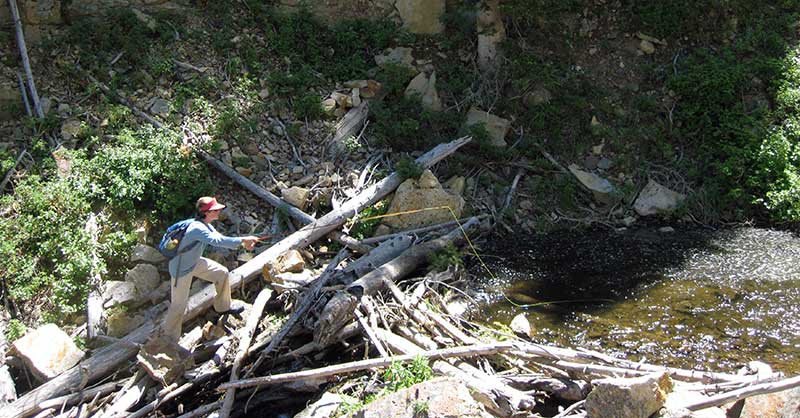
So are many small streams, though most aren’t quite this rugged.
Early Summer Yellowstone and MT Fishing Trips: Quick Facts
- Best Waters: The sky is the limit in early summer. Large and small rivers like the Yellowstone, Gardner, and Lamar are good now, as are all of their tributaries. YCFF tends to focus on hike-in sections of the Yellowstone, Lamar and tributaries, and Gardner and tributaries.
- Three Top Reasons to Come in Early Summer: 1.) Early summer offers the widest range of fishable waters in YNP, as well as the most consistent fishing overall. 2.) Except for occasional thunderstorms, the weather is at its most consistent during this period. 3.) This is the best time of year to match hatches in Yellowstone Park, from small mayflies on up to the fabled Salmonfly.
- Three Top Reasons to Avoid Early Summer: 1.) This is the most crowded time of year for both general tourism and anglers in the park. 2.) This is the hottest time of year, so hiking can sometimes be a sweaty affair. 3.) Rivers can still be high, so wading is tougher now than in late summer and fall.
- Perfect Clients: Early summer is ideal for adventurous, fit anglers eager to hike who are willing to put up with crowded roads and sometimes crowded rivers (even in the backcountry) in exchange for the most consistent fishing of the year, if not always the best fishing of the year.
- What Early Summer Does Best: Provides a huge range of fishing opportunities, from small fish in small streams to large cutthroat trout in big rivers.
July Trips: The Details
When the rivers across the northern portion of Yellowstone Park drop out of their spring runoff between the last week of June and the middle of July, options for walk-wade trips spike dramatically. The month or so following the end of the runoff offers the widest range of options for walk trips, especially for beginners, anglers who like to hike, and those who want to chase cutthroat trout.
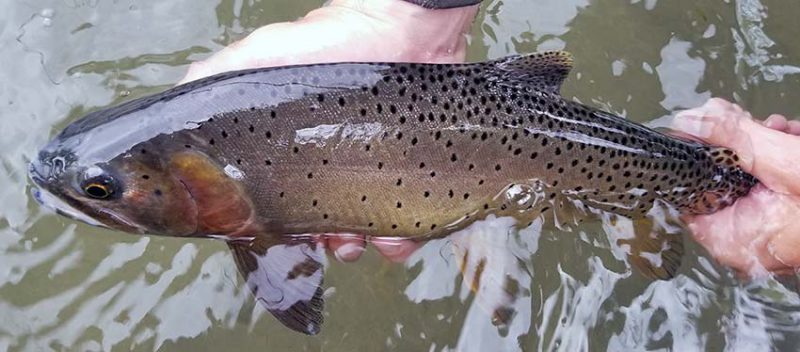
Native Yellowstone cutthroat trout are a primary target species in July, both inside and outside the park.
The best options for full-day trips for experienced anglers throughout this period are the Yellowstone in its Grand and Black Canyons and rugged portions of Slough Creek and the Lamar River. We’ll often put together a trip focusing on one of these waters for most of the day that concludes on the Gardner River or one of the fun, out-of-the-way small streams that becomes fishable at this time.
Because angler crowds are heavy near the roads in early summer, it is vitally important to hike to shed crowds. When possible, we also like to fish water with rugged banks and fast water, because such a stream character really deters the masses. The ultimate example of this type of water is found on the canyon sections of the Yellowstone, which explains why this is by far our favorite walk-in river for experienced anglers during the summer.
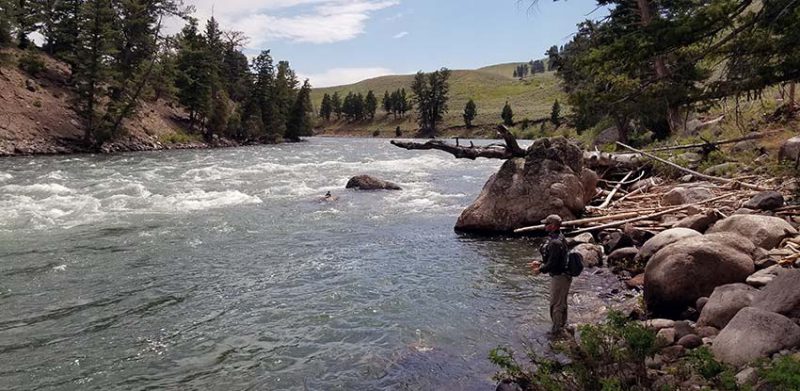
On July Yellowstone fishing trips, most Yellowstone River fishing inside the park revolves around the Salmonfly and Golden Stonefly hatch. While this hatch typically lasts only a week or ten days outside the park, it can last as much as a month inside it. These finger-length bugs can attract even the largest trout to the surface.
Even if they don’t want to rise, the fish will take big nymphs hung as droppers under large dry flies. When the fish want an “after dinner mint” instead of the main course, smaller attractor dries and attractor nymphs also work well, especially during caddisfly or Yellow Sally stonefly hatches.
Our Yellowstone fishing guides usually carry a spare rod rigged with streamers on the Yellowstone, and the streamers can be a blast to fish in the deep green pools found on this stretch of the Yellowstone. The trout here love to chase, and will often follow flies during the retrieve all the way to the rod tip before striking, making for the most visual streamer fishing we’ve ever found.
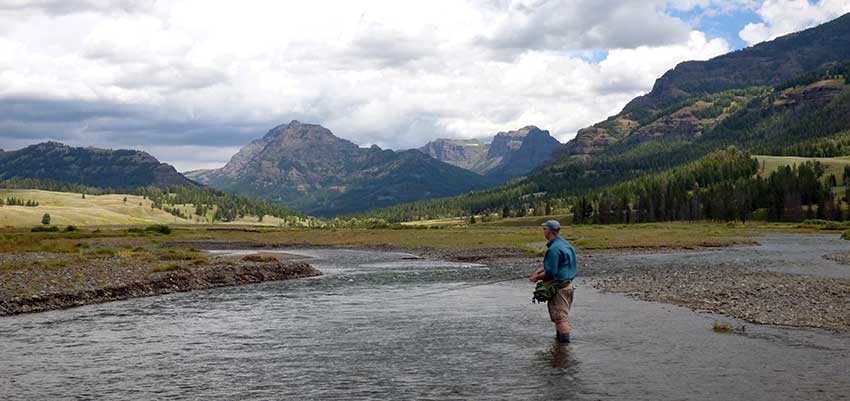
The view is definitely part of the appeal on Soda Butte Creek.
Mayfly hatches are also excellent on certain waters during this period, particularly the Western Green Drake hatches which can get the fish really excited. These hatches are most common on the Lamar River and its main tributaries Slough Creek and Soda Butte Creek, as well as a few smaller streams.
For anglers interested in this match-the-hatch fishing, we typically guide on the rugged portions of the Lamar and Slough, as well as on a couple waters we won’t name online. This water is suitable for anglers of a variety of skill levels, provided they’re up for some rock-hopping.
We also guide on the meadow portions of the Lamar, Soda Butte, and Slough Creek, though it is often very difficult to shed crowds on these waters. The views can’t be beat, though.
Beginner options are great at this time. Enthusiastic beginners can do well on many small, rough streams holding cutthroat, rainbow, and brown trout. Those who want to be sure of catching a bunch of fish (though no big ones) should think about starting with a half-day on a small brook trout stream. Often a half-day on such a creek is enough, but many beginners like to combine a half-day on a brookie creek with an afternoon on more-challenging water on the Gardner or Yellowstone after lunch, trying to add a couple bigger, harder fish to the mix.
Full-day and half-day trips are available at this time. We start almost all Yellowstone Park trips in early summer between 6:00 and 7:00 depending on our meeting place and travel time. It’s vital to be through the gate before about 7:45 to avoid risking a half-hour line waiting to get in. Montana half-days are more likely to start at midmorning.
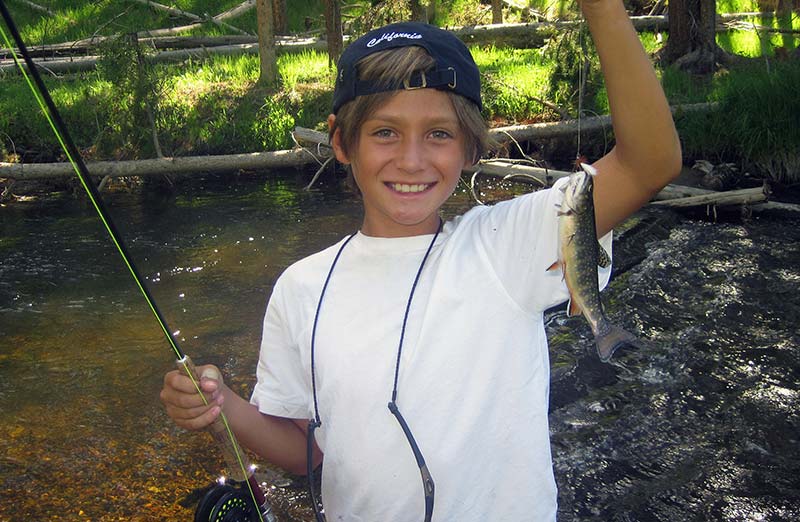
July is prime beginner season.
Late Spring Yellowstone Park Fishing Trips
Posted on January 24th, 2024

Angler fishing a pool on the Firehole in early spring.
Introduction to Late Spring Yellowstone Park Fishing Trips
Yellowstone Park opens to fishing at sunrise on the Saturday of Memorial Day Weekend. On the opener, usually only one to three rivers are low enough and clear enough to fish due to spring snowmelt. These rivers, the Firehole, Gibbon, and the headwaters of the Madison (created by the junction of the Firehole and Gibbon), are fed by lakes and geyser basins, so they never get as high and muddy as other rivers in the park. This makes them by far the best options for late spring Yellowstone Park fishing trips.
There are no good public water walk & wade options available outside the park in this timeframe within our operations area, due to the spring melt and accompanying high, muddy water.
In dry years, more river options are available in early June, particularly the Grand Canyon of the Yellowstone and the lower Gardner. They’re fishable before June 15 no more than one year in three, though. Better options that usually become fishable sometime in the first week or two of June are several hike-in lakes and a small handful of gently-flowing creeks.
After mid-June, the Grand Canyon of the Yellowstone and lower Gardner become steadily better options even in wet years, while the Firehole drops off. Sometime in late June or the first few days of July, the Firehole and Gibbon both get tough and the rest of the water across the northern part of Yellowstone Park joins the Gardner and Grand Canyon, and the fishing transitions to early summer.
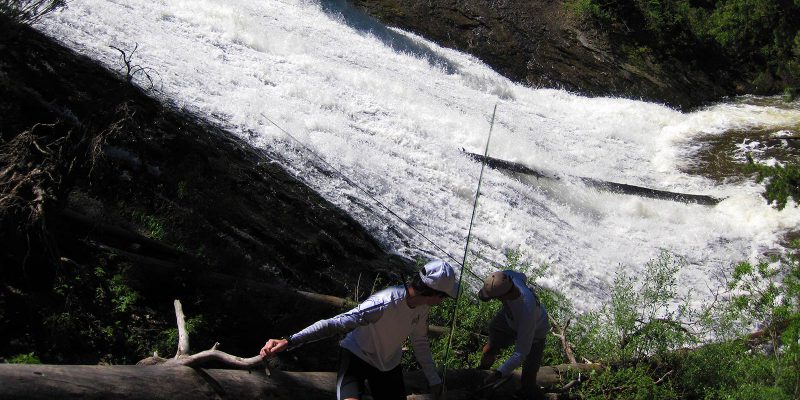
Young anglers climbing out of a rough section of the Gibbon River after fishing.
Late Spring Walk & Wade Trips: Quick Facts
- Best Waters: The Firehole, Gibbon, and Madison Rivers are the most consistent waters in late May and June, but a few small lakes and streams join them in the second week of June or so.
- Three Top Reasons to Come in Early Spring: 1.) You are interested in fishing the geothermal Firehole and Gibbon, where geysers and hot springs compete with trout for your attention 2.) General tourist crowds are always modest, and angler crowds are low except in roadside areas. 3.) After lakes begin to clear, this is a great time to fish for Arctic grayling.
- Three Top Reasons to Avoid Early Spring: 1.) Most Yellowstone Park trout caught at this time are small. 2.) The weather is inconsistent, particularly before June 10 (it might snow or be 80 degrees). 3.) Fewer fisheries are good in spring than during peak season; in fact there are no wade options outside the park at this time.
- Perfect Clients: Spring fishing in Yellowstone Park is ideal for anglers who don’t mind smaller trout and grayling in exchange for smaller crowds and good opportunities for wildlife and geyser viewing to go with the fishing.
- What Early Spring Does Best: Produces good numbers of smaller trout on dry flies and dry-dropper rigs, but only in a few places.
Late Spring Yellowstone Park Fishing Trips: The Details
In the first couple weeks of the season, we spend most of our time on spring Yellowstone fishing trips on the Firehole and Gibbon. The geyser-heated Firehole River is typically at its very best for the first couple weeks of the season. In dry years, the Gibbon River is also good right out of the gate, and even following cold, wet winters it is usually ready to go between June 5 and June 10.
Since the Firehole is a gentle, meadow river with heavy insect hatches and spooky (though mostly small) trout that fishes best in the mornings, and much of the Gibbon is fast and rocky, filled with trout eager to eat attractor dry/dropper combos, and good in the afternoons, these two streams make an excellent one-two punch to open the park season. The Firehole is awfully far from Livingston, so it’s only available for full-day trips, but the Gibbon is a reasonable option for half-days.
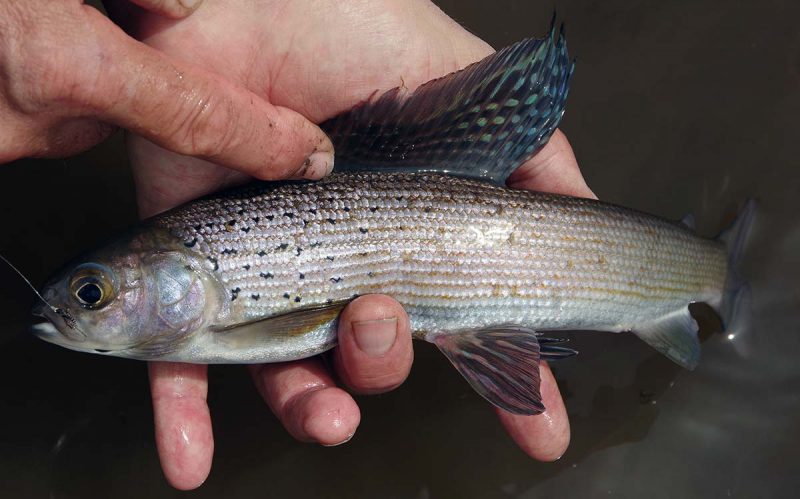
Early June grayling from a Yellowstone Park lake.
For anglers interested in something different, some excellent small lakes become available after approximately June 5, particularly Cascade Lake, which holds gorgeous cutthroats and the best populations of the rare Arctic grayling in the region. We’ll often pair this lake in the morning with the Gibbon after lunch in mid-June. This pairing too provides a good mix of fishing, since the lake is either subsurface fishing with nymphs and streamers or match-the-hatch dry fly fishing, while the Gibbon continues to be an attractor dry fly show.
This trip is a good choice for beginners, especially since we can work on casting without the complication of current on the lake. This trip is a full-day only option, and we’ll want to be hitting the trail by 9:00AM.
A few other lakes also turn on in early June, including some which hold larger cutthroat and brook trout, though these are some combination of much harder to access and much less consistent from a fishing perspective.
By mid-month, additional waters drop out of runoff, with the precise options depending on the progress of the snowmelt. These include options within reasonable half-day range of Livingston. A couple small stream options almost always appear at this time, while for surefooted anglers who like short-range nymphing the Gardner River can be outstanding, since this river is full of big stoneflies that are preparing to hatch and the trout go nuts for them.
During dry years, small portions of the Yellowstone in its lower Grand Canyon also become fishable by mid-June. This is hike-in fishing with big nymphs and streamers, and it often flies under the radar. A few seasons ago we had a client catch a hundred and six trout on a full-day on the Yellowstone at this time. Needless to say, if it’s clear enough, this is where we’ll go in mid-late June.
Since some half-day options are available at this time, we might meet early or around midday. Some of the small stream opportunities at this time are the first “beginner brookie” options of the year. Before that, we tend to fish the Gibbon River with beginners.
>>>>>>>>>>>>>>>>>> Return to Walk & Wade Trips Page
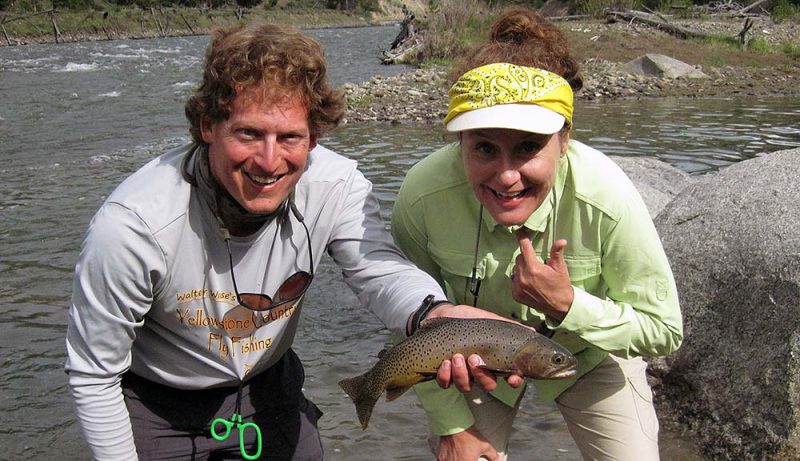
This fish was caught on a spring Yellowstone fishing trip in early June on the Yellowstone River during a low water year.
Late Fall Float Trips
Posted on January 23rd, 2024
Late Fall Float Trips: Introduction
Late autumn begins when nights begin falling below freezing most nights rather than just occasionally and the first snow that doesn’t all melt by midafternoon starts to fall now and again. Most years, the first week of October is when this occurs.
After the switch flips there’s no reason to get out early in the morning save for hardcore anglers who want to try for one or two really big fish with streamers. The best fishing is typically from about 10:00AM through about 4:00PM. For this reason, almost all late fall trips operate as “shoulder season” 3/4-day trips, with 5–6 hours on the water.
Fishing is slow-paced at this time, with nymphs and streamers pounded in the deeper runs the most likely producers, but big numbers of rising trout also possible during good BWO hatches. This is the time of year when guides do most of their fishing. Little wonder. The big fish are eating, but there isn’t much work. Want to find out why the guides tend to like fishing during this period?
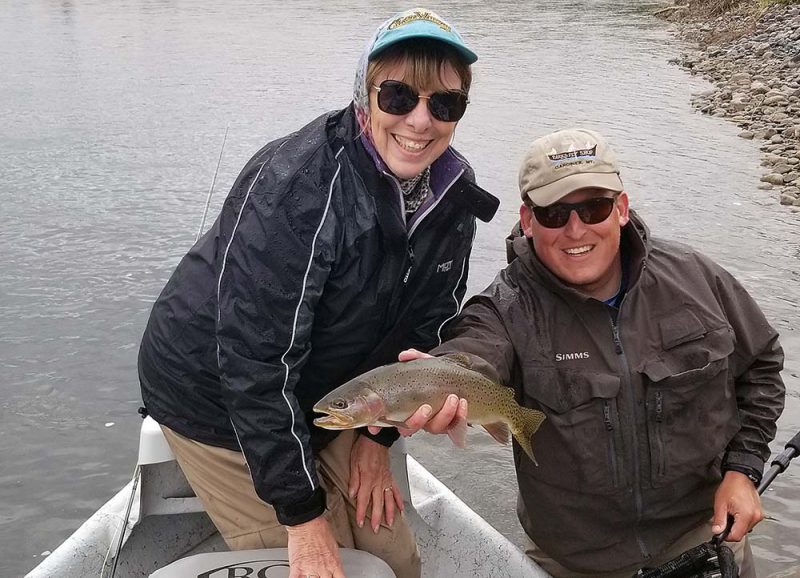
Late Fall Float Trips: Quick Facts
- Best Waters: All waters that remain high enough to float this late in the year can be excellent, but we generally stick close to home on the Yellowstone.
- Three Top Reasons to Come in Late Autumn: 1.) This is an excellent time to target big fish, 2.) Crowds are nonexistent, and 3.) the dry fly fishing can still be good for a couple hours each afternoon, and it’s generally much better than early spring.
- Three Top Reasons to Avoid Late Autumn: 1.) Weather and water conditions are wildly inconsistent and can be miserable: it can snow feet and remain below freezing for days at a time, or be too warm and bright. 2.) The numbers of fish caught on an average day are far lower than in summer, and 3.) Morning fishing is very slow most days.
- Perfect Clients: Experienced anglers who want to fish nymphs and streamers for larger fish, with a solid chance of some good dry fly fishing many afternoons.
- What Late Autumn Does Best: Produces big browns on their spawning runs and the rainbows that follow them looking for a meal of eggs.
Late Fall Float Trips: The Details
Things fall apart in late fall (October and early November), but they fall apart in a delightful way. With the possible exception early spring, this is the best big fish period of the season on float trips, and since the early autumn hatches continue to a degree, this is still an okay time for solid numbers of trout on dry flies as well.
The top rivers at this time are the Yellowstone, the lower Madison, the Missouri near Holter Dam, and the lower Gallatin, Jefferson, and the Missouri River headwaters (these last three waters only for those wanting one or two monster trout). We spend most of our personal and guiding time on the Yellowstone.

Most fishing during this period is subsurface, with streamers producing the largest fish and midge pupae, BWO nymphs, and egg imitations producing the numbers. BWO hatches continue and can produce good dry fly fishing for an hour or two in the afternoons and the fish willing to eat the nymphal forms of these bugs much of the rest of the time. The main driver of the fishing at this time isn’t bugs, however. It’s the upcoming or underway brown trout spawn.
In early October, the big browns are migrating to spawning areas and feeling aggressive, making streamers targeting these fish the best tactic.
In late October and early November, the browns are in the midst of their spawn. We do not target actively spawning wild trout on any of our trips, but the non-spawning rainbows, cutthroats, and even non-spawning or pre-spawn browns that hang below their cousins chomping eggs are fair game. Egg imitations are the best flies for these fish, but they’re frequently quite aggressive to a variety of flies, including dead-drifted streamers and mayfly nymphs as well as eggs.
Weather and water conditions can be rather… burly… at this point in the year. Early cold snaps in particular can make both the fishing and just being on the water a challenge. Ideal conditions see air temperatures between 45 and 55 degrees with cloud cover, drizzle, and occasional flurries. Let that sink in. Gross and uncomfortable weather produces the best fishing. The bright, sunny, warm, Indian summer sort of days most people love to see in October are poor for angling at this time. “Winter in October” is also bad, but it does require seriously ugly weather for us to consider canceling: temperatures below freezing, with wind and precipitation. Bear that in mind before booking a float for this period.
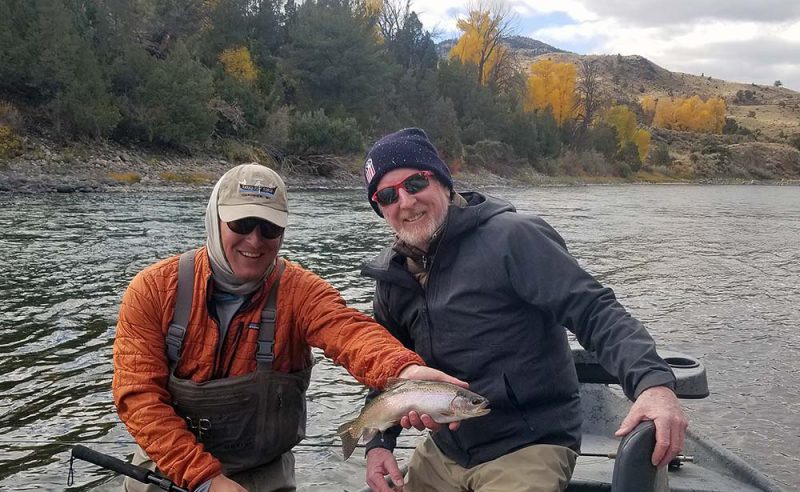
There’s almost never any reason to get out early during this period, particularly after the middle of October. We mostly run half-day trips meeting around 10:30AM.
Late fall floats are better for experienced anglers who know what they’re getting into in terms of the weather, but particularly early in this period they’re still good bets for beginners, and they’re not poor choices for rookies right up until it gets too cold to want to float for the rest of the year. This is because nymph tactics in slow-moving water are often the best tactic for numbers of trout, often with the boat stopped in likely areas. This give beginners plenty of second chances to get the casts and drifts right and will not overwhelm them.
This is a poor time for young kids, since they often get cold/wet/miserable given the “standard” fall weather.
Our float season concludes sometime in early November when it gets too cold to make these trips feasible.
>>>>>>>>>> Back to Float Trips Page
